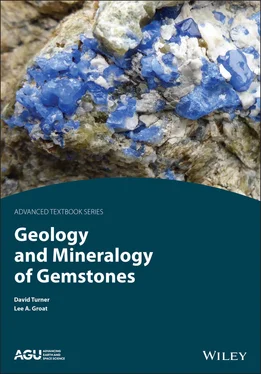Mixtures differ from compounds in that a mixture is comprised of two or more compounds that are not interacting through chemical bonding. The world of rocks and minerals is a perfect example of this. Minerals, like sapphires, are compounds that are held together through chemical bonding. Rocks, on the other hand, can be thought of as bulk mixtures of minerals held together through an interlocking physical network of mineral grains notthrough chemical bonding. This is similar to how furniture can be made whole with joints, nails, and screws that physically hold the pieces together while the individual pieces are independently held together through chemical bonding that make up the wood itself.
Chemical bonds are attractive forces between atoms. In a simplistic view, they form when outer electrons from two or more atoms interact, resulting in their atoms becoming “joined”. The two main types of bonding seen in nature are ionic and covalent.
Ionic bonding occurs between two atoms, one with a strong tendency to gain electrons (the anion) and the other with a strong tendency to lose electrons (the cation). Here, the cation can be thought of as having “donated” electrons (therefore becoming positively charged with less electrons than it started with) to the anion (which then becomes negatively charged with the extra electron). Normal table salt (NaCl) is a good example of ionic bonding where sodium, which usually has a valence of +1, combines with chlorine, which usually has a valence of −1, in a one‐to‐one ratio. This is a simple case and in reality most compounds are more complicated than this. In the mineral world, most bonding that occurs is ionic bonding, where electrons are donated from cation to anion.
Covalent bonding occurs when atoms “share” valence (or outermost) electrons between them. Covalent bonding is much more common in organic compounds (those that form living matter). However, in the gem world, this type of bonding is best observed in diamond. Diamond is a compound made up of carbon (C). The carbon atoms share electrons between them in a tight 3D network forming “molecules” of interconnected carbon atoms. These covalent bonds are very strong and give diamond its hardness and strength.
Another type of bonding that is less common in nature, but commonly studied by scientists, is metallic bonding. This is the type of bonding that, not surprisingly, is typical in native metals such as silver, gold, and copper. Valence electrons in metallically bonded compounds are shared throughout the entire material (not simply between two atoms) and are “free” to move about.
Van der Waals bonding is another type of bonding found in nature but seldom in minerals. This form of bonding is quite weak and when present often defines cleavage planes, such as in the mineral graphite.
1.4 Physical Properties of Minerals
Each mineral has a distinct chemical composition and internal arrangement of atoms and bonding. Accordingly, every mineral will exhibit distinct physical properties.
Color is the most familiar of the physical properties and often what draws people to minerals and gemstones. In a simple sense, color is described as the outward appearance of mineral as observed by our eyes. It is a function of the nature of the incident light and its interaction with the mineral, including effects from transmission, reflection, refraction, scattering, and absorption of visible light. Minerals that display little to no absorption of visible light will appear white if light is scattered off the surface (as in kaolinite) or transparent if light is transmitted through the crystal (as in pure quartz). Despite being an easy to observe property, color is actually not a very good diagnostic property on its own. This is because many minerals can exhibit a range of colors depending on the impurities within them. This concept is developed in greater detail later, as it is critical to the world of gemstones.
Luster refers to how visible light interacts with the surface of a mineral. Minerals with metallic luster show strong reflection of light off their surfaces, as in the case of polished gold or the mineral pyrite (iron sulfide). Minerals with nonmetallic luster generally absorb at least some of the incident light in addition to reflection. Types of nonmetallic luster include vitreous, resinous, dull, earthy, pearly, greasy, silky, and adamantine.
Streak refers to the color of a mineral after it has been ground along the surface of a ceramic or porcelain streak plate. The process of grinding the mineral into finer particles results in a more even display of a mineral’s color under incident light. Streak is often more diagnostic for minerals than color.
Habit describes the common ways that a mineral crystallizes into macroscopic forms. Habit can be described through the examination of the external form of a mineral specimen, which can be either an individual crystal or an aggregate of crystals that grew together. Terms used to describe individual crystals include platy, pyramidal, bladed, lamellar, acicular, tabular, or prismatic. Terms used to describe aggregates of crystals include fibrous, reniform, botryoidal, dendritic, radiating, concentric, massive, or stalactitic.
Cleavage, parting, and fracture describe the ways in which minerals break under force. Cleavage is the occurrence of discrete planes of weakness in a mineral that correlate to weaknesses in the internal bonding and atomic structure of that mineral. Cleavage is often described as perfect (as in micas), good (as in epidote), imperfect (as in beryl), or indistinct (as in tourmaline). Cleavage planes will be straight and repeated in different orientations of a mineral as dictated by that mineral’s overall symmetry, and therefore can be described using crystallographic orientations and patterns (e.g., octahedral cleavage, as in fluorite).
Parting is when a mineral will preferentially disaggregate in a somewhat consistent manner but in a way that is not controlled by the atomic arrangement of atoms and therefore will not be repeated based on a mineral’s underlying symmetry ( Figure 1.5). Fracture is described as the irregular breakage (commonly curved) of a crystal and can sometimes be diagnostic, as in quartz, which exhibits conchoidal fracturing, or kyanite, that exhibits splintery fractures.
Tenacity is the resistance of a mineral to break or bend. Easily breakable minerals are termed brittle (as in kyanite, Figure 1.6) while those that can bend and return to their shape are termed elastic (as in mica‐group minerals). Bendable minerals that do not return to the shape but that do not break apart are termed flexible. Minerals with metallic bonding can be malleable (hammered into thin sheets, as in gold), ductile (can be drawn out into wires), or sectile (can be cut into slices).
Hardness is a measure of a mineral’s resistance to scratching against another mineral and is related to its bonding characteristics. The Mohs hardness scale is a relative ranking of common minerals and their hardness. Gemstones are generally high up on the ranking, as it is important for them to not be easily scratched. In order from soft to hard, the Mohs scale (developed in the early 1800s) is defined by the following index minerals: talc (1), gypsum (2), calcite (3), fluorite (4), apatite (5), orthoclase (6), quartz (7), topaz (8), corundum (9), and diamond (10). Half increments are often used, as in the case of beryl that has a hardness of ~7.5–8. Because hardness is a function of bonding within a mineral, it is also technically a property that may vary depending on the direction of scratching. For example, kyanite shows a hardness of 5 parallel to its length and 7 across the length, while garnet exhibits a hardness of 7.5 in all directions. Hardness can also be measured by other methods and scales, such as Vicker’s Hardness or the use of a sclerometer, an instrument that measures the width of a scratch made by a diamond on the sample under controlled conditions.
Читать дальше












